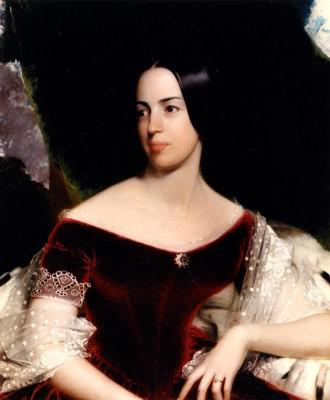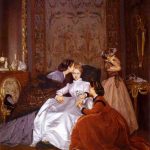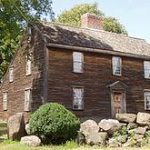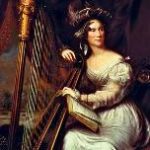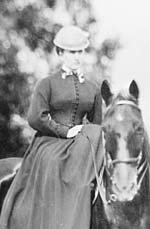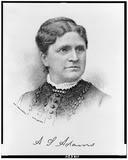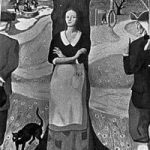Wife of Charles Francis Adams
Abigail Brown Brooks was born April 25, 1808 in Medford, Massachusetts, the youngest of three daughters of Peter Chardon Brooks and Ann Gorham Brooks. Peter Brooks was one of the wealthiest men in Boston, and he and his wife were highly regarded in Boston society.
Image: Portrait of Abigail Brooks Adams
By William E. West, 1847
Third son of John Quincy and Louisa Adams, Charles Francis Adams was born August 18, 1807 in Boston. He spent most of his early childhood abroad, where his father had diplomatic appointments. Charles Francis, like his father and grandfather, attended Harvard College, graduating in 1825. He spent the next two years studying law in Washington DC while his family occupied the White House. Returning to Boston in 1827, Charles Francis studied in the law office of Daniel Webster; in 1828 was admitted to the bar.
Courtship
Nineteen-year-old Charles Francis Adams met Abigail Brooks from Medford, Massachusetts in early 1827 at her sister Charlotte’s home in Washington. It was love at first sight and after only a month of courting Charles proposed and Abigail accepted – if her father approved the match. Peter Chardon Brooks was not quite ready to allow Abigail, his youngest daughter, leave the family fold. He thought they were too young and insisted that they wait until Charles reached the age of twenty-one and established his law practice.
Charles opened a law office but apparently he was careless in keeping appointments and records; his father criticized him for being aimless and irresponsible. As they waited, Abigail and Charles exchanged numerous love letters, expressing their undying love as they anticipated their life together.
John Quincy and Louisa Adams had three sons who lived to maturity. The failures of their two older sons might be traced to 1809, when President James Madison appointed their father Minister to St. Petersburg, Russia. Ignoring his wife’s tears, John Quincy left their older sons, George Washington Adams and John Adams II, with family. Their youngest son Charles Francis, barely two, accompanied his parents. A daughter, Louisa Catherine Adams, was born and died in St. Petersburg, Russia, shortly after her first birthday.
When their parents departed for Russia, leaving them with family, George Washington Adams and John Adams II were eight and six years old. Grandparents John and Abigail Adams were charged with overseeing the boys’ education. On December 24, 1814, John Quincy Adams was at the signing of the Treaty of Ghent, which ended the War of 1812 between the United States and United Kingdom. He was assigned as Minister to England soon after. Therefore, the John Quincys did not see their older boys for five years; they did not return to live in the United States permanently until 1817. By then, George and John II were young men, aged sixteen and fourteen.
George Washington Adams, eldest son of the John Quincys, led a troubled life. He never married and he had a reputation as an alcoholic and ladies’ man. He suffered from depression, an illness that was not recognized at that time, and was predisposed to gloom and paranoia. John Quincy summoned George to Washington DC in early June 1829. Taking the Benjamin Franklin out of Boston, George was suffering from delusions, pleading with the captain to return to shore because the other passengers were conspiring against him. George disappeared on June 9, while the boat was in Long Island Sound. His body washed ashore on June 13, 1829. He was 28 years old.
Marriage and Family
Abigail Brooks was finally allowed to marry Charles Francis Adams on September 3, 1829. After their wedding, the couple moved into a house on Hancock Avenue in Boston to begin what proved to be a happy life together. After experiencing his brother’s death, his marriage to Abigail Brooks, and a long overdue reconciliation with his father, Charles Francis Adams became a more focused and goal-oriented person. He later stated that if not for Abigail Brooks, he would never have accomplished anything in life.
Abigail sometimes struggled with her health and spirits, particularly while their seven children were small. However, she was fun-loving and sociable and insisted that Charles participate in social events, thus preventing him from becoming a social recluse. She also took an interest in his public service.
Abigail Brooks Adams, in the tradition of her grandmother-in-law and mother-in-law, was an outspoken woman. She wrote letters back home to her family, calling President James Buchanan a toad and one of her husband’s colleagues a pig. In one letter she writes, “If any young woman wants to have a nice, quiet life, I advise her not to marry an Adams.”
Another Son Lost
John Adams II had studied at Harvard University but was expelled during his senior year for participating in the 1823 student rebellion to protest the curriculum and living conditions at the University. Fifty years later, most of the students who took part in the protest were awarded Bachelor of Arts as of 1823 and admitted to Harvard’s Roll of Graduates. John Adams II was among them – thirty-nine years after his death – a bit late to assuage his father’s anger.
After being ejected from Harvard, John II studied law under his father, and when he became President, he served as his father’s private secretary at the White House. At a reception there, Russell Jarvis, a reporter for the Washington Daily Telegraph, who was critical of the Adams administration, accused President Adams of publicly insulting his wife. When the President claimed he was immune, Jarvis challenged John II to a duel. Jarvis’ continued effort to provoke an altercation culminated in a highly publicized fistfight in the Capitol Rotunda, where Jarvis repeatedly slapped the president’s son, but he refused to retaliate.
A committee of the U.S. House of Representative investigated the incident and determined that Jarvis had initiated the attack, but they took no further action. Newspaper editors who supported Andrew Jackson accused John II of cowardice. Louisa Adams always believed that the negative press generated by this incident led to her son’s later troubles.
Another situation arose that probably did not promote brotherly love in the household. Louisa Adams’ niece Mary Catherine Hellen lived with the Adams family after her parents died, and all three Adams brothers became rivals for her affections. In 1828 John II and Mary Hellen were wed at a ceremony in the White House. Both his brothers refused to attend the wedding, indicating there were hard feelings. John II and Mary Hellen became parents to two daughters, Mary Louisa and Georgiana Frances.
After John Quincy and John II left the White House in 1829, John II decided on a career in business, first attempting to operate his father’s flour mill in Washington. The venture was apparently not successful.
On September 30, 1833, John Quincy Adams wrote:
There is no passion more deeply seated in my bosom than the longing for posterity worthily to support my own and my father’s name. … For this I have done my part. My sons must do theirs.”
Despondent over his lack of success at his father’s mill and his brother George’s alcoholism and subsequent suicide on June 9 that year, John II slipped into his own alcohol-induced hell. He died October 23, 1834 in Washington, DC. He was 31 years old.
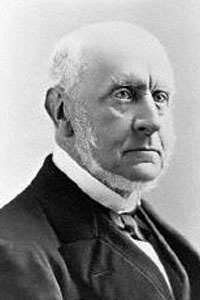
Charles Francis Adams
The deaths of his brothers left only Charles to carry on the family tradition of public service and prominence in American government. Those expectations must have been a heavy load. He began in the 1830s by contributing articles about local and national political affairs to Boston newspapers and the North American Review. He was then elected to the Massachusetts legislature, serving three years in the House (1841-1843) and two in the Senate (1844-1845). There he dealt with policies of an age of industrialism, immigration and democracy, and emerged as an antislavery leader.
Image: Charles Francis Adams
While John Quincy Adams served in Congress (1830-1848), Charles took care of the Adams property the elder Adams possessed, enabling his father to serve his country once again. Charles was content to tend the property, for which his father gave him an allowance. He also looked after his family, and read and wrote about history and other subjects that interested him.
During this time Charles Francis also served in the Massachusetts legislature from 1840 to 1845, and the slavery controversy propelled into prominence. Adams became a leader of conservative antislavery members who were resisting the spread of slavery into other states and territories. During the issue surrounding the annexation of Texas, Adams became one of the leaders of the Conscience Whigs, a faction of the Whig Party that demanded guarantees that slavery would not be expanded into the American West.
In 1848, the Free Soil party nominated Adams for vice president and Martin Van Buren as their presidential choice, but they were defeated. Adams curtailed his political activities during the 1850s. In this decade he published a ten-volume edition of his grandfather’s papers. Charles Frances and Abigail then moved to Quincy and began to refurbish the property known as the Old House at Peacefield, which he inherited after his father’s death on February 23, 1848.
Charles Francis Adams served as a Republican member of the U.S. House of Representatives from 1858 until 1861. Just before the American Civil War broke out, he was chairman of a northern commission in the House that worked for conciliation between the North and South. He supported William Henry Seward for the Republican presidential nomination in 1860 but accepted President Abraham Lincoln‘s offer to serve as U.S. minister to Great Britain. Through his firm but skillful negotiations, Adams persuaded the British not to recognize the Confederacy.
Abigail supported Charles Francis in his political endeavors. When he was sent as Minister to England at the beginning of the Civil War, she went with him. Her nephew, William Everett described those years in her obituary printed in the New England Historic and Genealogical Register of July 1889 praising her for:
… maintaining her country’s honor in the most trying circumstances of English social life, where the aristocratic sentiment was notoriously hostile, with a combination of generosity, playfulness, frankness, constancy, culture and dignity.
In 1863 Adams convinced the British government to prevent Confederate ironclad ships, built in Liverpool, from leaving port, thereby maintaining British neutrality. James Russell Lowell said that “None of our Generals, nor Grant himself, did us better or more by trying service than he [Charles Francis Adams] in his forlorn outpost in London.”
Adams tended to minor diplomatic matters after the war, but he longed to return to Quincy. Finally, in April 1868, his resignation as U.S. minister to Great Britain was accepted. He left England with no regrets but with satisfaction at having steadily guided American interests in England during a critical period.
Preserving the Adams Family Papers
Charles Francis Adams was also a gifted historical editor who helped make the family’s most important writings available to the public. In 1840, he published a collection of remarkable letters written by his grandmother Abigail Adams, which continue to inspire new works of literature and scholarship. From 1850 to 1856, he completed a project his father had started: editing 10 volumes of John Adams’ diaries, political writings, letters, and speeches, which were published as The Works of John Adams in 1856.
In 1870, Charles built what is considered to be the first presidential library in the United States: the Stone Library, built of stone so it would be fireproof. The library houses the books and papers of four generations and sits just yards from Peacefield, the family home in Quincy, Massachusetts. The majority of its 12,000 volumes belonged to John Quincy Adams.
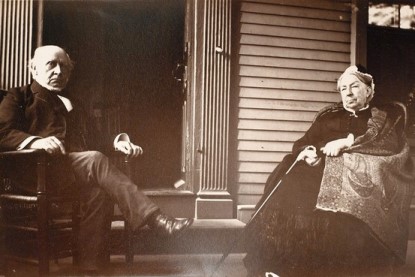
Image: Charles Francis Adams and Abigail Brooks Adams
At Peacefield in Quincy, Massachusetts, circa 1883
Photograph taken by their daughter-in-law, Clover Adams
Credit: Massachusetts Historical Society
Charles Francis and Abigail Brooks Adams lived their final years at Peacefield, during which time Charles transformed it from a working farm into a gentleman’s country estate.
Charles Francis Adams died in Boston on November 21, 1886, and newspapers in England and the United States mourned his death. Abigail’s health and spirits declined rapidly after his death.
Abigail Brooks Adams passed away at the Peacefield in Quincy, Massachusetts June 6, 1889.
Excerpt from Adams National Historical Park:
From the sweet little farm at the foot of Penn’s Hill to the gentleman’s country estate at Peacefield, Adams National Historical Park is the story of heroes, statesmen, philosophers … and learned women whose ideas and actions helped to transform thirteen disparate colonies into one united nation.
SOURCES
Wikipedia: John Adams II
Wikipedia: George Washington Adams
The Adams Sorrow: The Second Generation
Massachusetts Historical Society: Adams Biographical Sketches
Adams National Historical Park: Charles Francis Adams (1807-1886)
